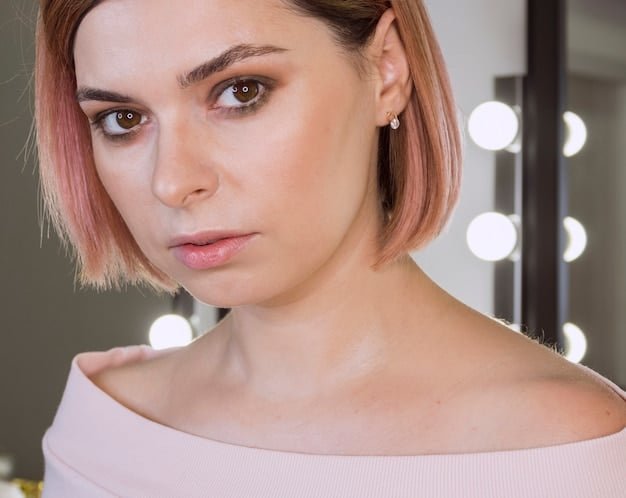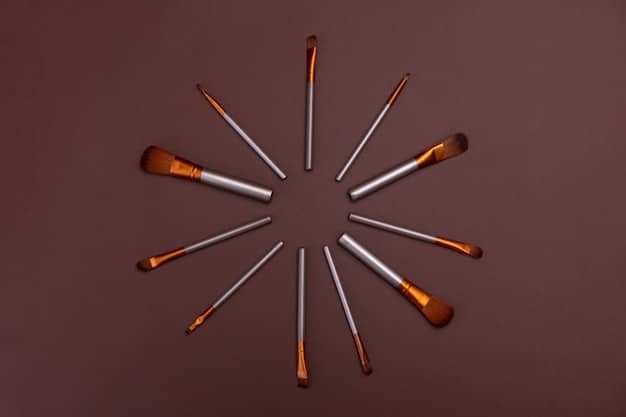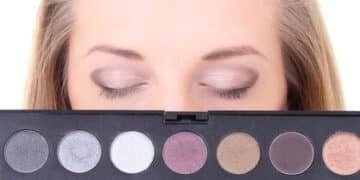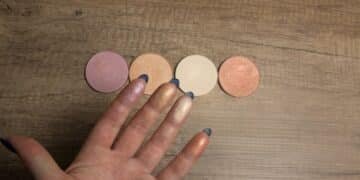Contour and Highlight Like a Pro: Beginner’s Guide (US)

Contouring and highlighting are makeup techniques that use light and dark shades to sculpt and enhance facial features; this step-by-step guide is designed for beginners in the US, providing easy-to-follow instructions to achieve a professional-looking sculpted face.
Ready to enhance your natural beauty and define your features? Sculpt Your Face Like a Pro: A Step-by-Step Guide to Contouring and Highlighting for Beginners in the US will unlock the secrets to creating dimension and radiance, transforming your everyday makeup routine.
Understanding the Basics of Contouring and Highlighting
Contouring and highlighting are essential makeup techniques that can dramatically enhance your facial structure. They work by creating shadows and bringing light to specific areas, adding dimension and definition.
What is Contouring?
Contouring involvesusing dark shades to create shadows, making certain areas of your face recede. It’s all about adding depth and defining features like cheekbones and jawlines.
What is Highlighting?
Highlighting, on the other hand, uses light shades to bring areas of your face forward, emphasizing them and creating a radiant glow. Common highlighting spots include the cheekbones, brow bone, and bridge of the nose.

- Contouring: Adds depth and definition by creating shadows.
- Highlighting: Emphasizes features and adds a glow by bringing light to specific areas.
- Balance: Contouring and highlighting work together to sculpt and enhance the face.
- Placement: Knowing where to apply each product is key to achieving a natural, sculpted look.
By understanding these basics, you’ll be well on your way to mastering the art of contouring and highlighting. Practice and experimentation are key to finding what works best for your unique face shape and preferences.
Choosing the Right Products for Your Skin Tone
Selecting the right contour and highlight products is crucial for achieving a natural and flattering look. The ideal shades and formulas will depend on your skin tone and type.
Contour Shades
For contouring, choose a shade that is two to three shades darker than your natural skin tone. The color should have cool undertones to mimic natural shadows. Avoid warm or reddish shades, which can look muddy.
Highlight Shades
For highlighting, opt for a shade that is one to two shades lighter than your skin tone. You can choose between matte, shimmer, or metallic finishes, depending on your desired level of glow. Consider your skin type; those with oily skin might prefer matte highlights to avoid excessive shine.
Product Formulas
Contour and highlight products come in various forms, including creams, powders, and sticks. Cream products are great for dry skin as they provide hydration, while powder products work well for oily skin due to their oil-absorbing properties. Sticks offer convenience and precise application.
- Fair Skin: Cool-toned taupe for contour, champagne or pearlescent highlight.
- Medium Skin: Neutral brown for contour, golden or peach highlight.
- Tan Skin: Deep cool-toned brown for contour, bronze or copper highlight.
- Dark Skin: Deep, rich brown for contour, gold or bronze highlight.
Experiment with different products and formulas to find what works best for your skin tone and type. Don’t be afraid to mix and match to achieve your desired sculpted look.
Essential Tools for Contouring and Highlighting
Having the right tools can make a significant difference in the application and blending of your contour and highlight products. Investing in quality brushes and sponges will help you achieve a flawless finish.
Contour Brushes
Angled contour brushes are ideal for applying powder contour products along the cheekbones and jawline. The angled shape allows for precise placement and easy blending. For cream contours, use a dense, synthetic brush to stipple and blend the product seamlessly.
Highlight Brushes
Tapered highlighter brushes are perfect for applying powder highlight to the high points of the face, such as the cheekbones, brow bone, and bridge of the nose. The soft, fluffy bristles ensure a diffused and natural glow. For cream highlights, use a small, damp sponge or a synthetic brush to gently dab and blend the product.

- Angled Contour Brush: Precise application of powder contour.
- Tapered Highlighter Brush: Diffused application of powder highlight.
- Dense Synthetic Brush: Seamless blending of cream contour.
- Small Damp Sponge: Gentle application of cream highlight.
With the right tools, you’ll be able to contour and highlight with ease, creating a professional-looking sculpted face. Remember to clean your brushes regularly to maintain hygiene and ensure smooth application.
Step-by-Step Guide to Contouring and Highlighting
Now that you have the right products and tools, it’s time to learn the step-by-step process of contouring and highlighting. Follow these instructions to achieve a beautifully sculpted face.
Step 1: Prep Your Skin
Start with a clean, moisturized face. Apply your foundation and concealer as usual to create an even base for your contour and highlight. Set your base with a light dusting of powder if you have oily skin.
Step 2: Apply Contour
Using your angled contour brush or cream contour stick, apply the product along the hollows of your cheeks, starting from your ear and blending towards the corner of your mouth. Also, apply contour along your jawline to define it, and along the sides of your nose to slim it.
Step 3: Blend, Blend, Blend
Use a blending brush or damp sponge to blend the contour seamlessly into your foundation. Avoid harsh lines by gently buffing the product into your skin, ensuring a natural, diffused finish.
Step 4: Apply Highlight
Using your tapered highlighter brush or cream highlight stick, apply the product to the high points of your face, including your cheekbones, brow bone, bridge of the nose, Cupid’s bow, and the center of your forehead. These are the areas where light naturally hits your face.
Step 5: Blend the Highlight
Use a clean brush or damp sponge to blend the highlight seamlessly into your skin. The goal is to create a radiant glow without any obvious lines or patches of product.
Step 6: Set with Powder (Optional)
If you have oily skin, set your contour and highlight with a light dusting of translucent powder. This will help to keep your makeup in place and prevent shine throughout the day.
With practice, you’ll be able to contour and highlight like a pro, creating a beautifully sculpted face that enhances your natural features. Don’t be afraid to experiment and adjust the placement and intensity of your contour and highlight to suit your preferences.
Contouring and Highlighting for Different Face Shapes
The best way to contour and highlight depends on your face shape. Understanding your face shape and tailoring your technique accordingly will result in a more flattering and natural look.
Round Face
If you have a round face, focus on creating angles and slimming your face. Apply contour along the sides of your forehead, temples, and below your cheekbones to add definition. Highlight the center of your forehead, bridge of your nose, and chin to elongate your face.
Square Face
For a square face, soften your features by contouring along the corners of your forehead and jawline. Apply highlight to the center of your forehead, cheekbones, and chin to bring these areas forward and create a more balanced look.
Oval Face
An oval face is considered the most balanced shape, so you can contour and highlight to enhance your natural features. Apply contour along the hollows of your cheeks and temples, and highlight the cheekbones, brow bone, and bridge of the nose.
Heart-Shaped Face
To balance a heart-shaped face, contour along the temples and the point of your chin to soften the width of your forehead. Highlight the cheekbones, brow bone, and Cupid’s bow to draw attention to the center of your face.
By adjusting your technique to suit your face shape, you can create a customized contour and highlight that enhances your natural beauty and complements your unique features.
Common Mistakes to Avoid
While contouring and highlighting can enhance your features, making these common errors can impact your look negatively. Here’s how to avoid them.
Using the Wrong Shade
Using a contour shade that is too warm (orange or red). The contour won’t create a natural shadow.
Harsh Lines
Failing to blend contour and highlighter completely, which will create harsh, unnatural lines.
Too Much Product
Applying too much contour or highlighter at once, resulting in a heavy, cakey finish.
Incorrect Placement
Placing contour too low on the cheeks. It can drag the face down. Apply highlighter where it naturally hits the skin.
- Choose Correct Undertones: Cool tones for contour; Warm tones for highlight.
- Blend Seamlessly: Buff away harsh lines for a diffused finish.
- Build Gradually: Apply in light layers for controlled intensity.
- Follow Face Shape: Tailor placement to enhance features.
By avoiding these common mistakes, you’ll be able to contour and highlight with confidence, achieving a flawless sculpted look that enhances your natural beauty.
| Key Point | Brief Description |
|---|---|
| ✨ Choosing Products | Select shades complementing your skin tone and type for a natural look. |
| 🖌️ Essential Tools | Use angled brushes for contour and tapered brushes for highlight for precise application. |
| 🔄 Blending | Blend products thoroughly to avoid harsh lines and achieve a seamless finish. |
| 👤 Face Shape | Adapt contour and highlight to your face shape for a harmonious and flattering look. |
Frequently Asked Questions (FAQs)
▼
Contour mimics shadows, using cool-toned shades to define features. Bronzer adds warmth, typically with shimmer or light-reflective particles, to give a sun-kissed glow. Use contour for structure and bronzer for warmth.
▼
Yes, you can use a concealer that is one to two shades lighter than your skin tone as a highlighter. Apply it to the high points of your face and blend well. Ensure it complements your skin tone.
▼
To avoid a muddy look, use a contour shade with cool, gray undertones. Apply the product in thin layers and blend thoroughly. Start with little product and build up as needed for a natural look.
▼
Cream contours blend best with a damp makeup sponge or a dense synthetic brush. Use stippling motions to press the product into the skin, avoiding streaks. This helps create a smooth, seamless finish.
▼
Clean your makeup brushes at least once a week to prevent bacteria buildup and ensure smooth application. Use a gentle brush cleanser or mild soap and water, and allow them to air dry completely before using.
Conclusion
Mastering the art of contouring and highlighting can transform your makeup routine, allowing you to sculpt your face and enhance your natural features. By following this step-by-step guide, choosing the right products and tools, and practicing regularly, you’ll be well on your way to achieving a professional-looking sculpted face that boosts your confidence and radiance.





